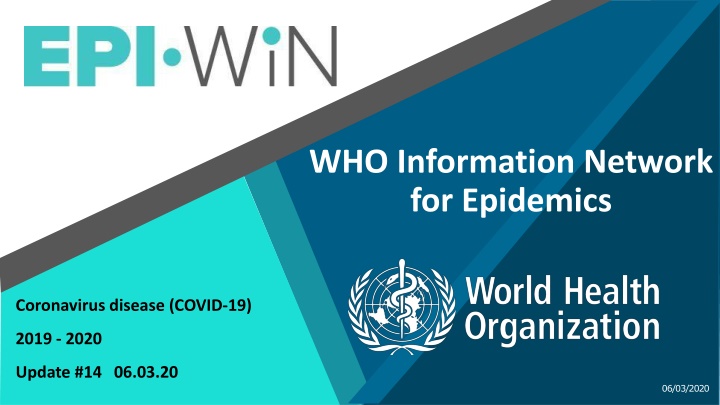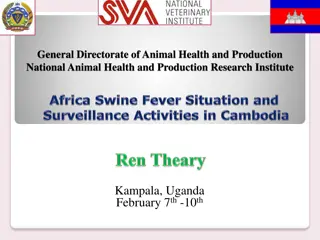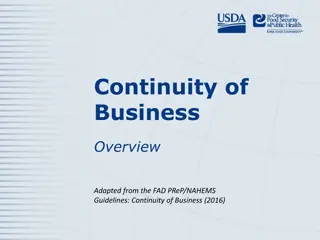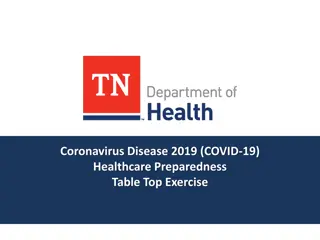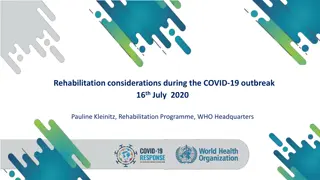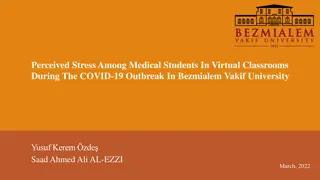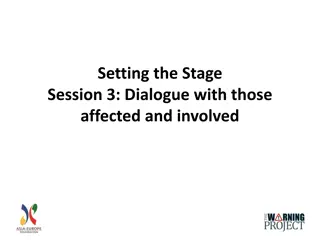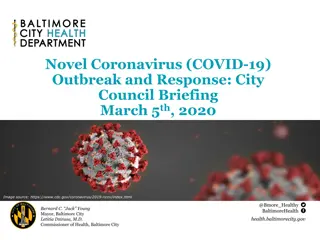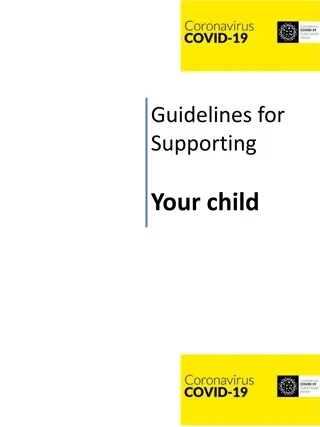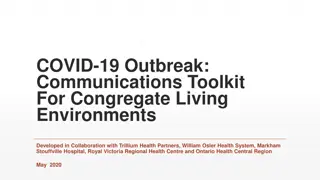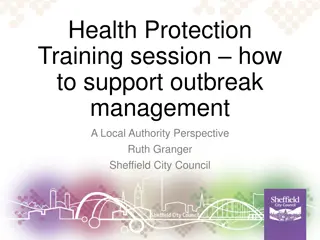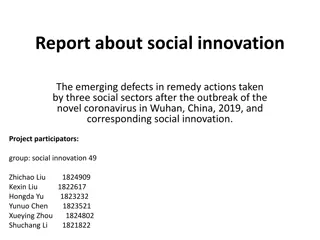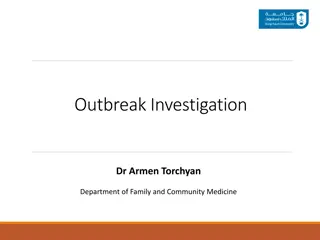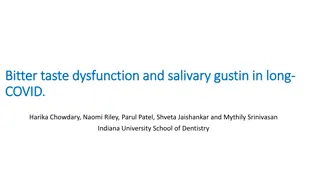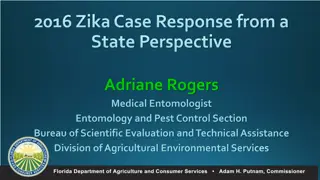Global Update on COVID-19 Outbreak
This update provides the latest global situation of the COVID-19 outbreak, including confirmed cases, deaths, and new cases. It also compares COVID-19 to influenza in terms of infectiousness and severity. The report highlights key differences and similarities between the two viruses, emphasizing preventative measures and transmission dynamics.
Download Presentation

Please find below an Image/Link to download the presentation.
The content on the website is provided AS IS for your information and personal use only. It may not be sold, licensed, or shared on other websites without obtaining consent from the author.If you encounter any issues during the download, it is possible that the publisher has removed the file from their server.
You are allowed to download the files provided on this website for personal or commercial use, subject to the condition that they are used lawfully. All files are the property of their respective owners.
The content on the website is provided AS IS for your information and personal use only. It may not be sold, licensed, or shared on other websites without obtaining consent from the author.
E N D
Presentation Transcript
WHO Information Network for Epidemics Coronavirus disease (COVID-19) 2019 - 2020 Update #14 06.03.20 06/03/2020
Cases by country/territory/area (as of 6 March 6am Gva) Current Situation Updates from last 24 hours Globally: 98,023 confirmed cases - 80,710 in China and 17,313 cases from 83 countries outside of China) Globally: 3,380 deaths China: 145 new confirmed cases 30 new deaths 102 new suspected cases Outside China: 2,591 new confirmed cases: Italy(769), Iran (Islamic Republic of)(591), Republic of Korea(518), France(138), Germany(138), Spain(63), Netherlands(44), Japan(32), Switzerland(29), The United Kingdom(29), Belgium(27), Sweden(26), Australia(23), Greece(23), United States of America(19), Canada(15), Ireland(12), Austria(8), Denmark(8), Czech Republic(7), Singapore(7), Occupied Palestinian territory (7), Ecuador(6), Georgia(6), Saudi Arabia(6), Finland(5), Malaysia(5), San Marino(5), Slovenia(5), Brazil(4), Thailand(4), Lebanon(3), Portugal(3), Bosnia and Herzegovina(2), Kuwait(2), Romania(2), Bhutan(1), Croatia(1), Egypt(1), Estonia(1), India(1), Liechtenstein(1), Morocco(1), Oman(1), Russian Federation(1), South Africa(1),International conveyance (Diamond Princess)(-10) 70 new death: Italy (41), Iran (Islamic Republic of) (15), Republic of Korea (7), France (2), Spain (2), Australia (1), Switzerland (1), United States of America (1) Source: WHO Situation dashboard https://experience.arcgis.com/experience /685d0ace521648f8a5beeeee1b9125cd 06/03/2020
New Cases of COVID-19 since 1 February 2020 4500 4000 New Cases in China New Cases Outside of China 3500 Number of new, confirmed daily cases 3000 2500 2000 1500 1000 500 0 06/03/2020
Science 06/03/2020
COVID-19 and Influenza: a brief comparison COVID-19 is less infectious than influenza but leads to more serious illness and death DIFFERENCES SIMILARITIES Both cause mild to severe respiratory disease and death. Influenza spreads faster than COVID-19: influenza has a shorter incubation period and shorter serial interval (time between successive cases) Spread by contact, droplets and fomites. Preventative measures the same: hand hygiene, respiratory etiquette, social distancing Transmission of virus before symptoms is a major driver of spread for influenza, not for COVID-19 virus The reproductive number is 2-2.5 for COVID-19 virus, 1-1.8 for pandemic influenza Children are commonly infected with influenza. Children are less infected and less affected by COVID-19. Severe illness and death seem to be more common in COVID-19 06/03/2020
Science update: evolution of COVID-19 virus Recent research that suggested emergence of two types of COVID-19 virus is criticized This study has been criticized by experts who have asked for retraction of the publication2 based on an over- interpretation of the data and methodological weaknesses in the study A recent published study1 suggested that two types of COVID-19 virus have been discovered and that one type was more aggressive and spread more quickly. This conclusion was based on the analysis of genetic sequence information from 103 samples of virus from China. The conclusions of the study risk spreading dangerous misinformation at a crucial time in the outbreak. This information was picked up by the media. 1. On the origin and continuing evolution of SARS-CoV-2. X. Tang, C. Wu, et al. National Science Review. 2020. 2. Response to: On the origin and continuing evolution of SARR-CoV-2. OA Maclean R Orton, et al. http://virological.org/t/response-to-on-the- origin-and-continuing-evolution-of-sars-cov-2/418 06/03/2020
New guidance 06/03/2020
Health workers exposure risk assessment and management in the context of COVID-19 virus A tool for health care facilities that have either cared for or admitted COVID-19 patients; To be used for all health workers who have been exposed to a confirmed COVID-19 patient in a health care facility The tool helps to determine the risk of COVID-19 virus infection and then provides recommendations for appropriate management of these HCWs, according to their infection risk Find below the links to the template for collecting the data contained within the tool and a corresponding data dictionary to facilitate the collection of this data. Photo credit: Irish Times Access the tool Access to the data template Access to the data dictionary Published 04.03.20 06/03/2020
1. KEY MESSAGES Water, sanitation, hygiene and waste management for COVID-19 Frequent and proper hand hygiene is one of the most important prevention measures for COVID-19. WASH practitioners should work to enable more frequent and regular hand hygiene through improved facilities and proven behaviour change techniques. 1 Existing WHO guidance on safe management of drinking-water and sanitation apply to COVID-19. Extra measures are not needed. Disinfection, in particular, will facilitate more rapid die-off of COVID-19 virus. 2 Full guidance available here: https://www.who.int/publications- detail/water-sanitation-hygiene-and- waste-management-for-covid-19 Many co-benefits will be realized by safely managing water and sanitation services and applying good hygiene practices. Such efforts will prevent many other infectious diseases, which cause millions of deaths each year. 3 Published 03.03.20 06/03/2020
2. Water, sanitation, hygiene and waste management for COVID-19 Update on transmission of COVID-19 Two main routes of transmission of COVID-19: respiratory and contact. Respiratory droplets are generated when an infected person coughs or sneezes. Any person who is in close contact with someone who has respiratory symptoms (e.g., sneezing, coughing, etc.) is at risk of being exposed to potentially infective respiratory droplets. Droplets may also land on surfaces where the virus could remain viable and thus the immediate environment of an infected individual can serve as a source of transmission (known as contact transmission). The risk of catching COVID-19 from the faeces of an infected person appears to be low. There have not been reports of fecal-oral transmission of COVID-19 to date. 06/03/2020
3. Water, sanitation, hygiene and waste management for COVID-19 Update on persistence of COVID-19 COVID-19 virus has a fragile outer membrane - it is less stable in the environment and can be killed by simple disinfectants There is no evidence, to date, on survival of the COVID-19 virus in water or sewage. Based on its structure, it probably does not survive long. It is not certain how long COVID-19 virus survives on surfaces: survival of other human coronaviruses on surfaces varies from 2hrs -9 days Survival time depends on the type of surface, temperature and humidity. Common disinfectants such as 70% ethanol and bleach can kill the virus 06/03/2020
4. WASH in homes and communities Wash hands regularly in homes, schools, and crowded public spaces such as markets, places of worship, train/bus stations, etc. before preparing food, before and after eating, after using the toilet and changing a child s nappy, and after touching and handling animals. When there are suspected or confirmed cases of COVID-19 in the home setting, some immediate actions that can be taken are: Regularly and frequently clean touched surfaces throughout the patient s care area Clean and disinfect bathrooms daily Use household soap or detergent for cleaning first After rinsing, use regular household disinfectant containing 0.5% sodium hypochlorite (i.e. equivalent 5000 pm or 1-part of household bleach with 5% sodium hypochlorite to 9 parts of water). Wear PPE while cleaning, including mask, goggles, fluid-resistant apron, and gloves. Clean hands with alcohol-based hand rub or soap and water after removing PPE. Guidance on WASH in healthcare settings is available https://www.who.int/publications-detail/water-sanitation- hygiene-and-waste-management-for-covid-19 06/03/2020
Some key epidemiological and technical insights from China Source: WHO China Mission Report 06/03/2020
Transmission dynamics the vast majority of cases arise from close contacts of symptomatic cases; 1-5% of 38,000 close contacts develop COVID-19 (based on carefully followed contacts in 3 areas) transmission in most settings is driven by family-clusters (i.e. 75-85% of clusters); we found no examples of children transmitting to adults the most careful studies of 20 household attack rates suggest it was 10% early in the outbreak and fell to 3% with faster isolation transmission in other closed settings is happening but is not the major driver in China (e.g. nosocomial infections, nursing homes, prisons, restaurants) school outbreaks have not been a feature of this outbreak this may simply be because of the closure of schools during most of this outbreak Wuhan city 06/03/2020
Natural history at diagnosis: approx. 80% are mild/moderate; 15% severe; 5% critical progression: approx. 10-15% of mild/moderate cases become severe, and approximately 15-20% of severe become critical average times: from exposure to symptom onset is 5-6 days after infection; from symptoms to recovery for mild cases is 2 weeks; Infection, prevention and control from symptoms to recovery for severe cases is 3-6 weeks; from symptoms onset to death is from 1 week (critical) to 2-8 weeks. truly asymptomatic infection appears to be rare (e.g. 1-3%) an estimated 75% of asymptomatic cases soon progress to disease children tend to have milder disease than adults; although COVID was less frequent in children & we did not see onward transmission from children, this may be an artifact due to school closures & other factors 06/03/2020
Virology virus shedding is highest early in the course of disease (vs. SARS shedding which peaks at least 5 days post onset) virus shedding can be detected in the 24-48 hours prior to disease onset virus can be isolated from stool but there is no epidemiologic evidence of fecal-oral transmission virus shedding usually continues for 7-12 days in mild/moderate cases, and for >2 weeks in severe cases Contact monitoring and case finding 06/03/2020
More information WHO sources: COVID-19 website: https://www.who.int/health-topics/coronavirus WHO Travel Advice:https://www.who.int/ith/en/ Email: EPI-WIN@who.int Website:www.EPI-WIN.com 06/03/2020
